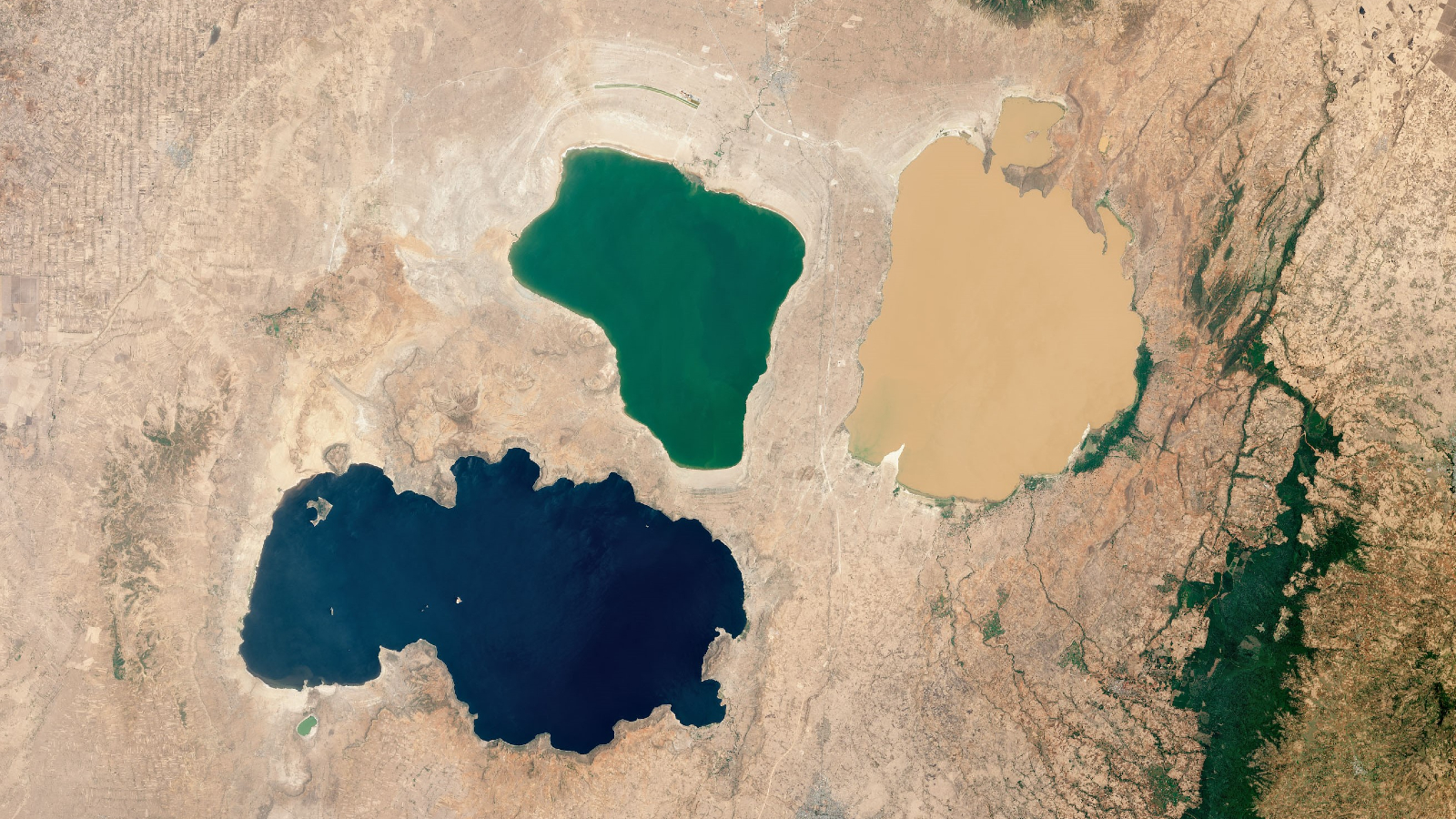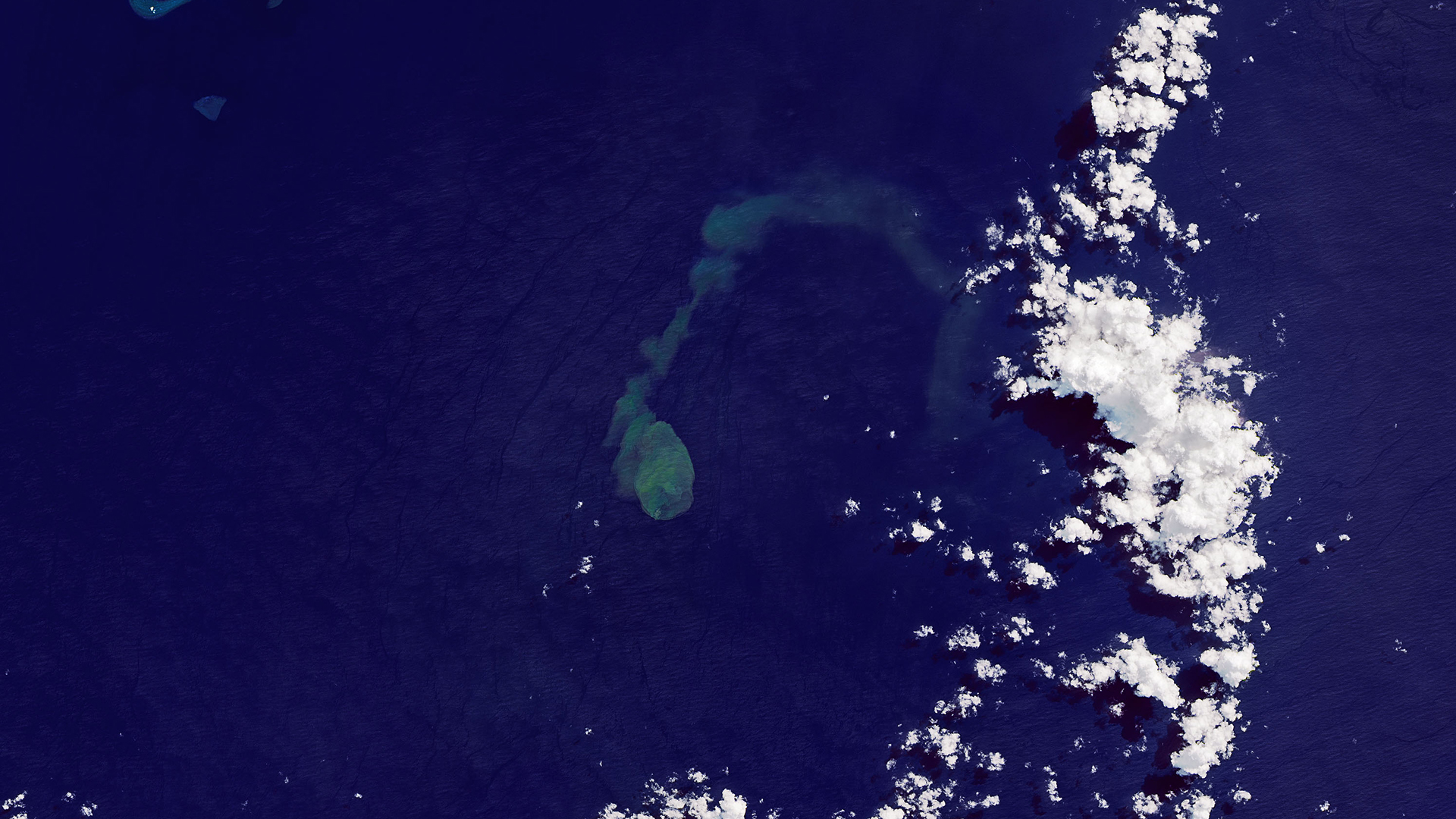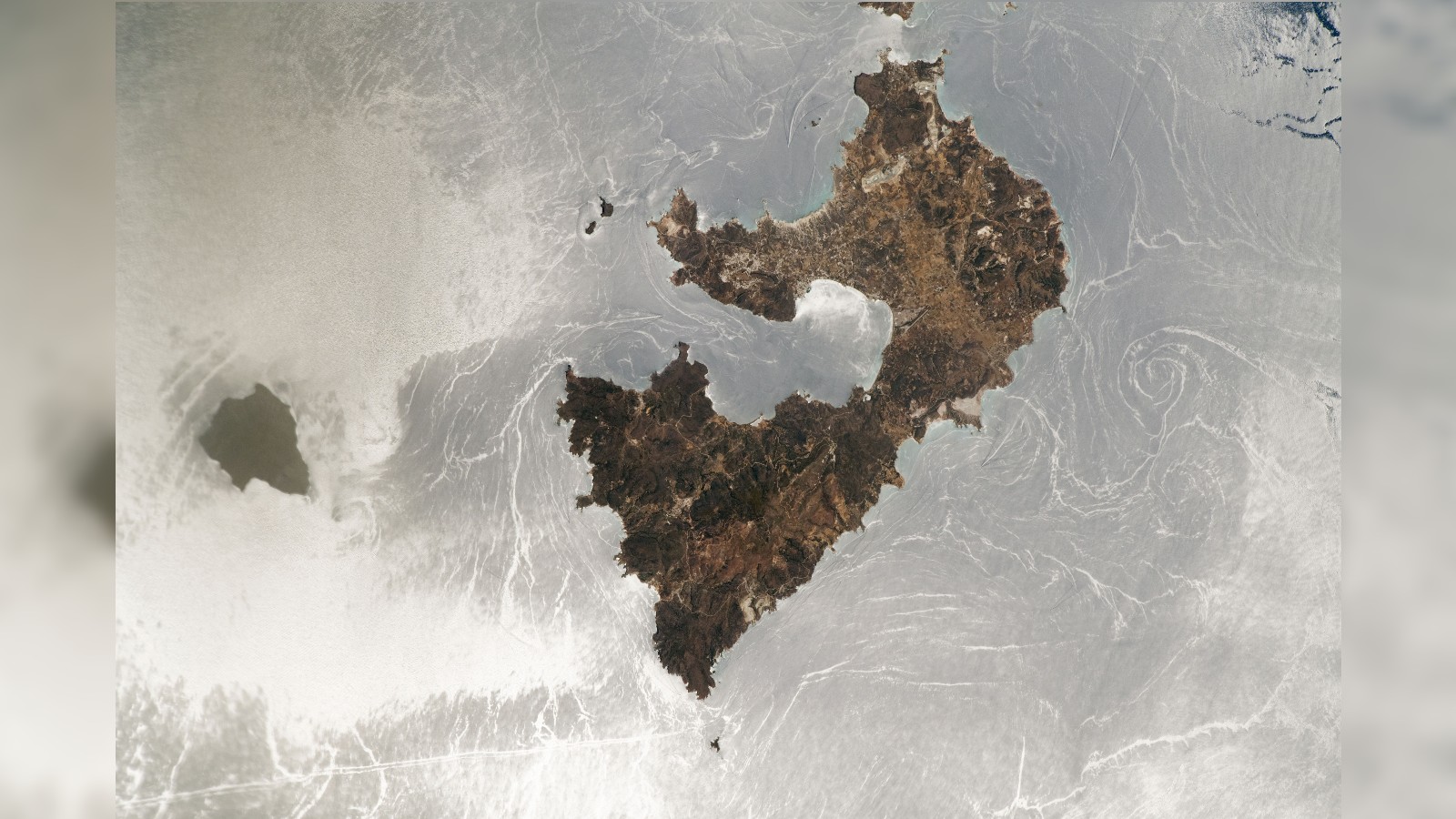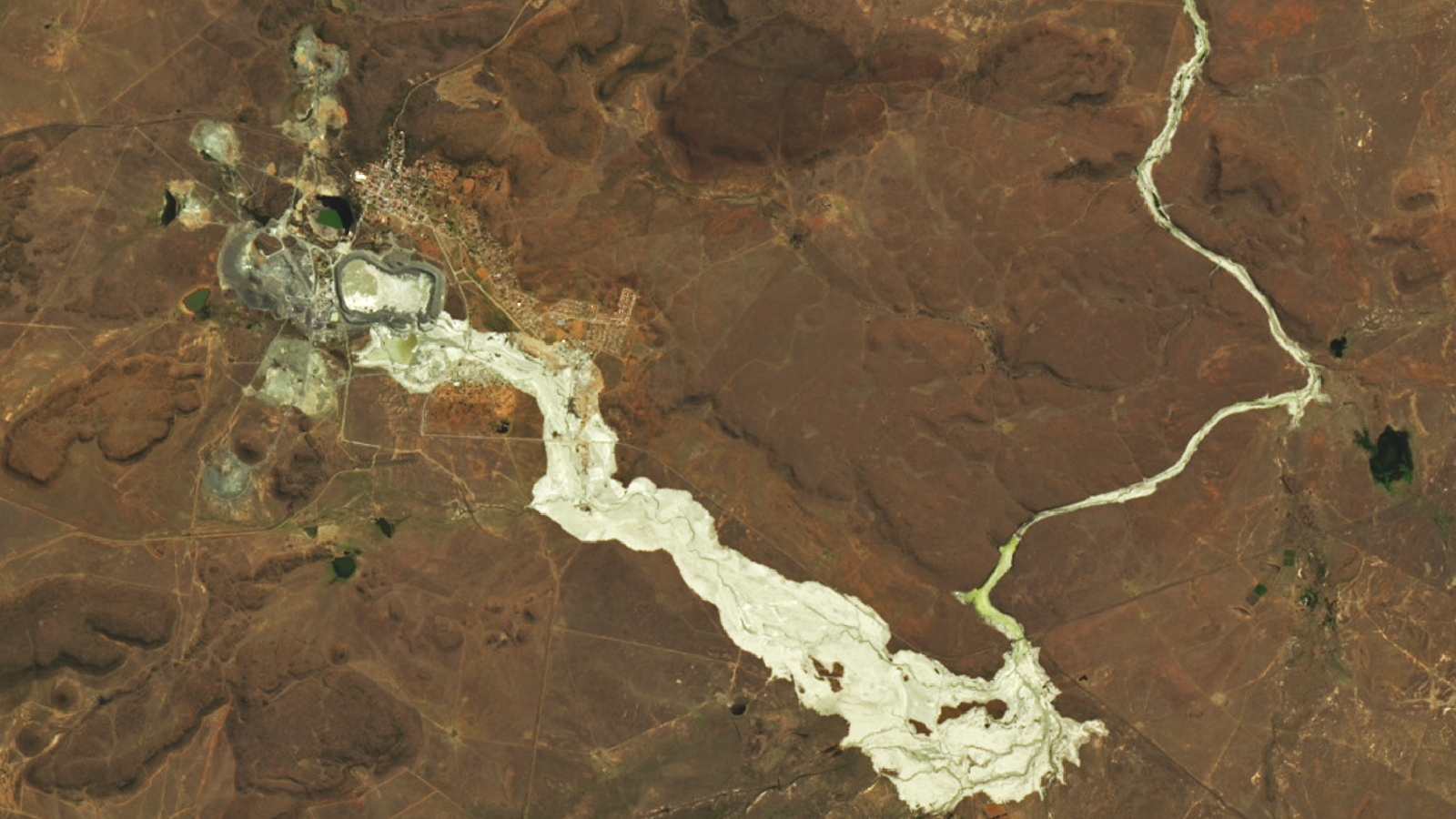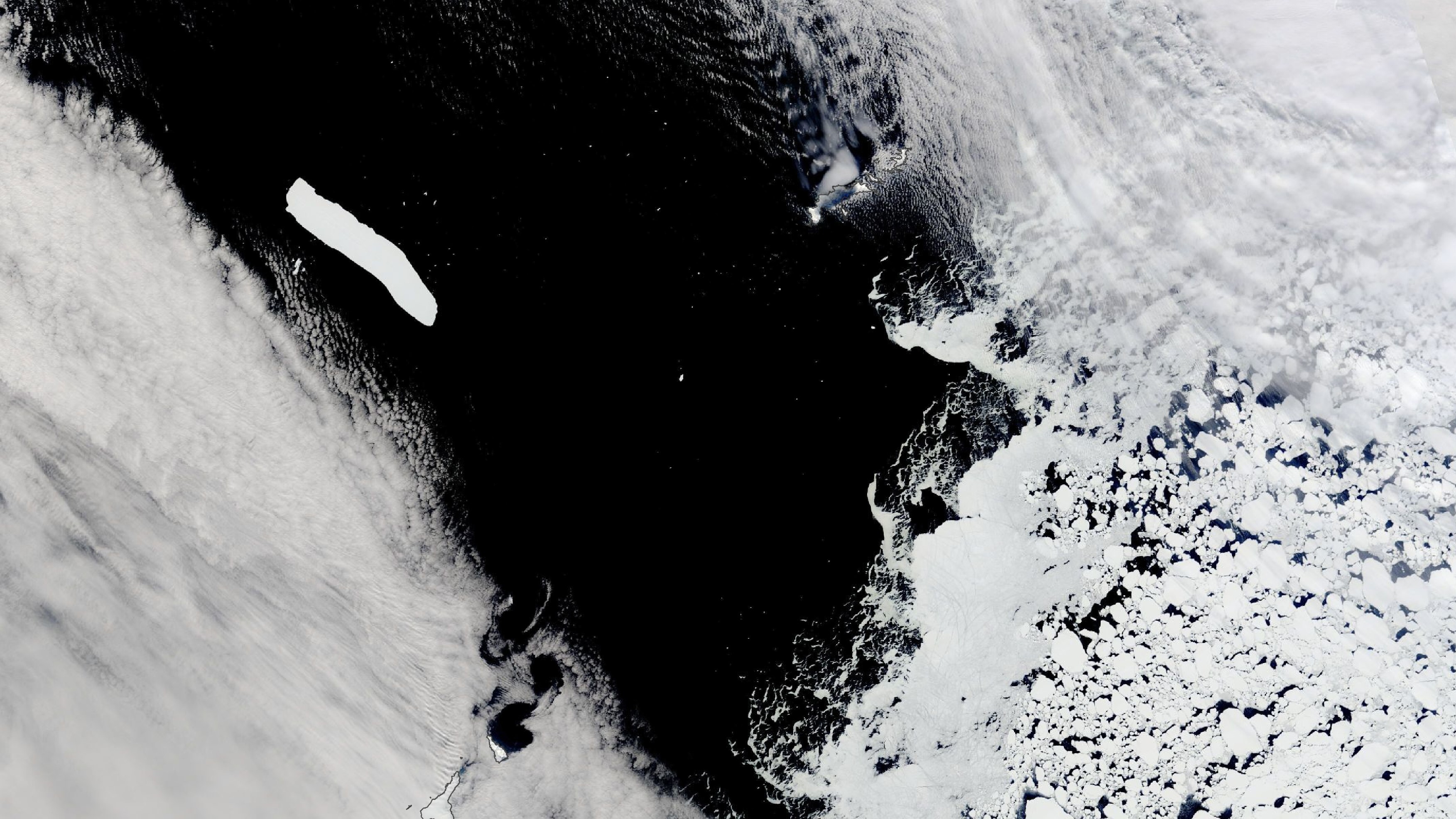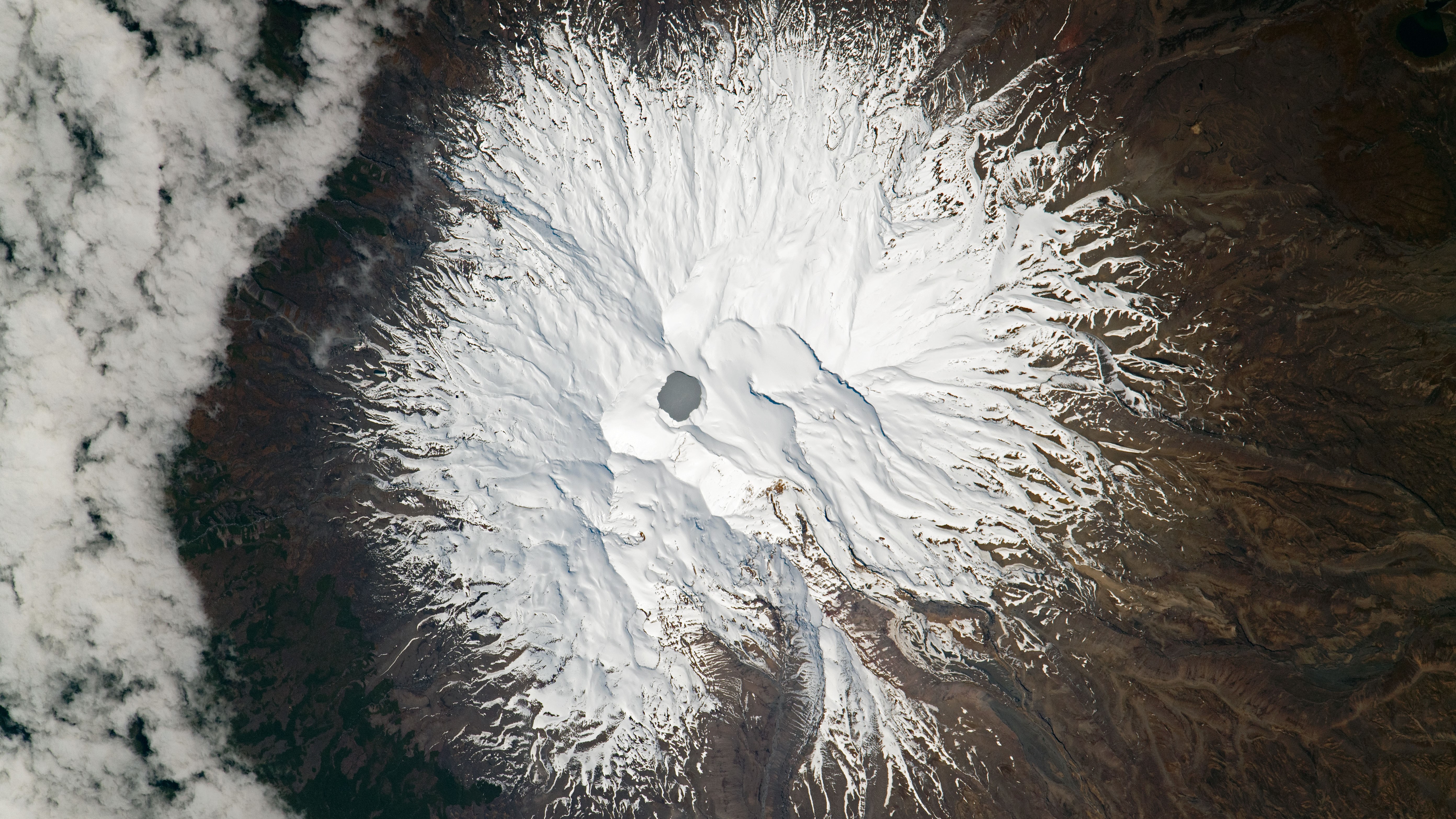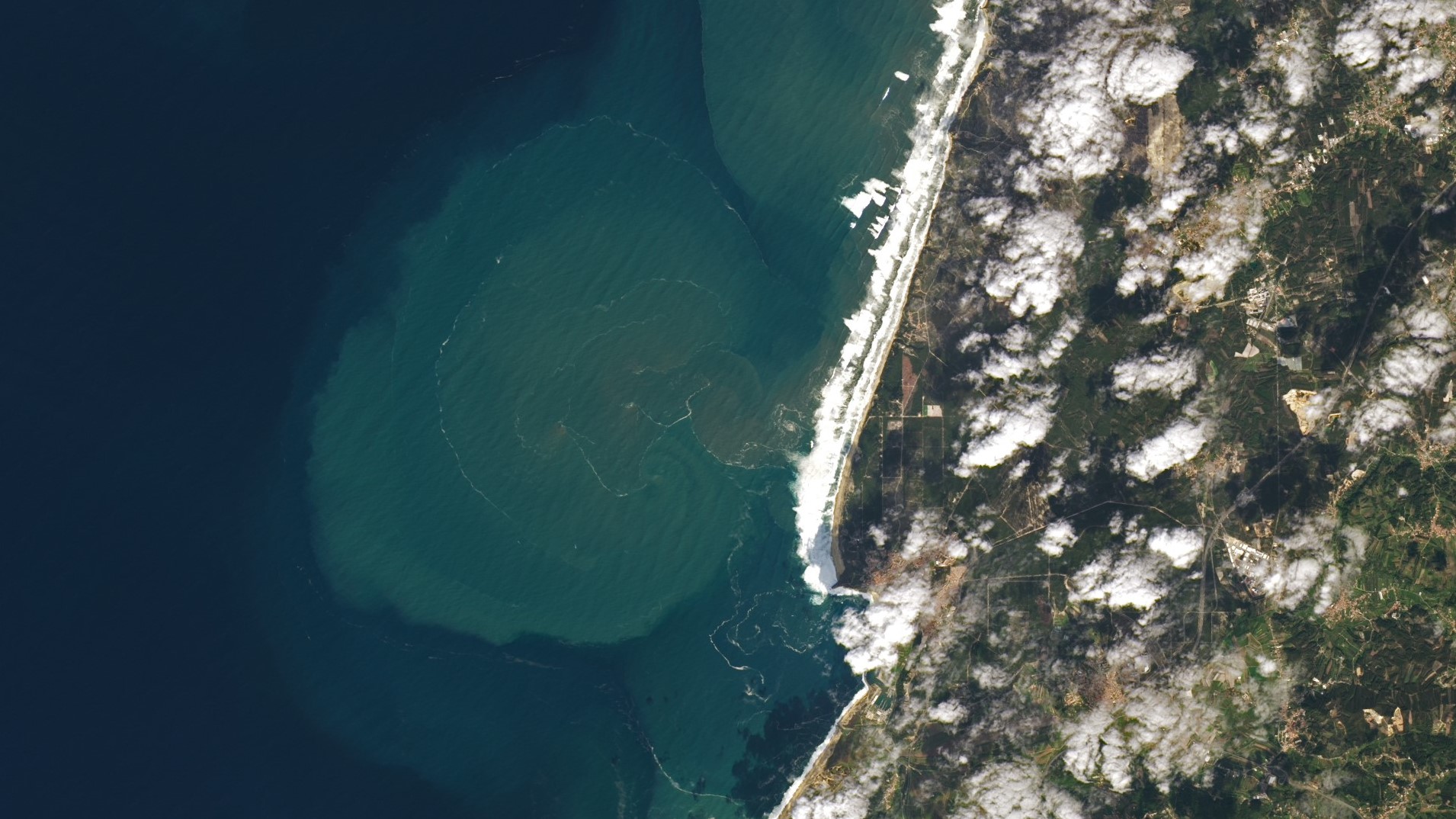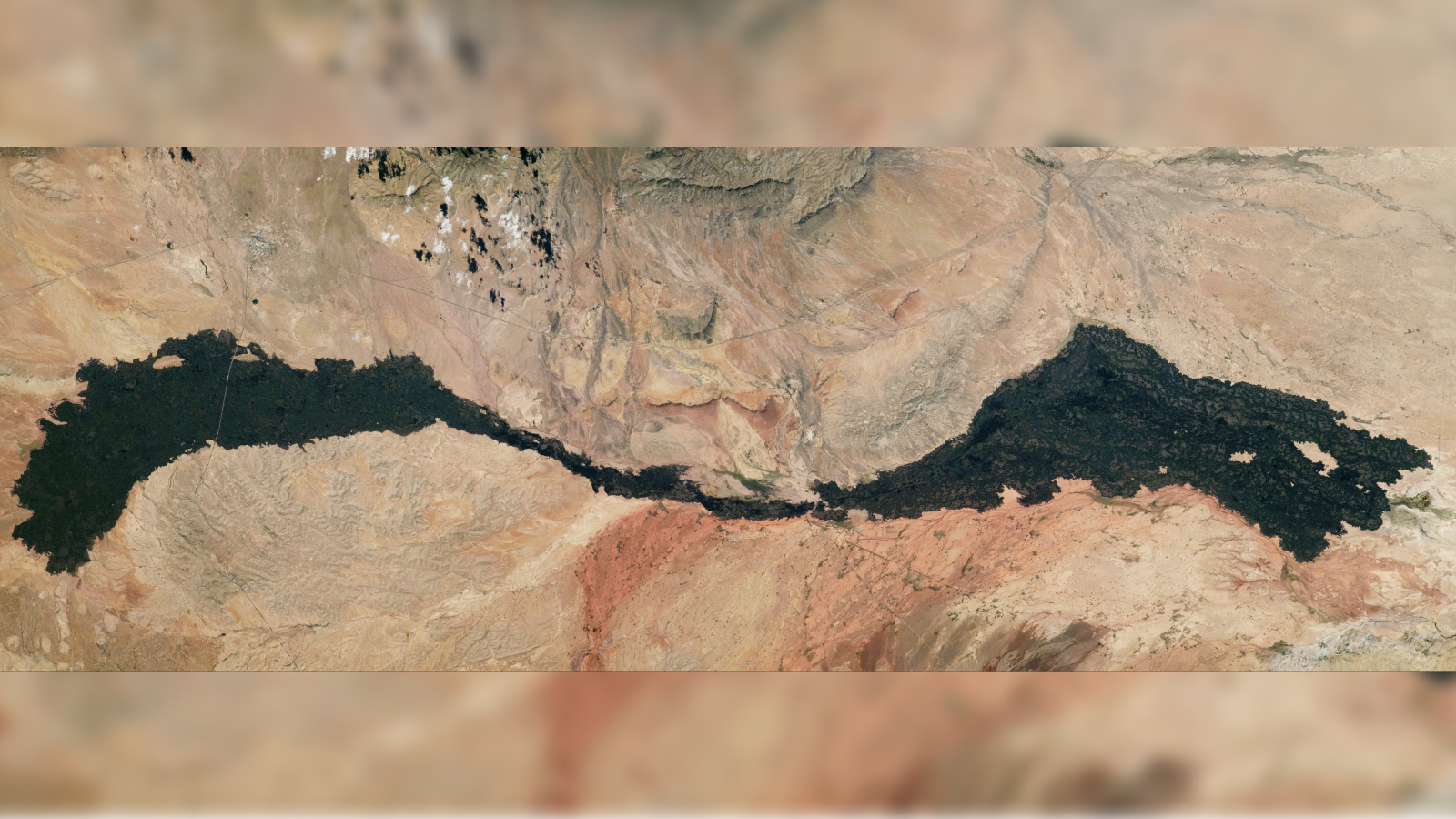10 stunning shots of Earth from space in 2022
A number of amazing shots of Earth were captured from space in 2022. Here are some of our favorites.
Earth-orbiting satellites and astronauts on board the International Space Station (ISS) have provided us with a whole new perspective of our planet in recent decades, and 2022 has been no different. From bizarre blue blobs and a silver swirling sea to undersea volcanoes and wandering icebergs, here are some of our favorite satellite and space station images of Earth released in 2022.
Trio of multicolored lakes
The Landsat 8 satellite, which is co-owned by NASA and the U.S. Geological Survey, snapped a striking real-color image of a trio of multicolored lakes in Ethiopia's Great Rift Valley: Lake Shala (left), Lake Abijatta (center) and Lake Langano (right).
Lake Shala's dark-blue hue is a result of its deep waters, which have a maximum depth of 873 feet (266 meters). Lake Abijatta, which only has a maximum depth of 46 feet (14 m), is green thanks to a bloom of photosynthetic algae. Lake Langano, meanwhile, gets its yellow color from rivers that carry nearby mountain sediments there.
The contrasting appearance of the lakes is even more surprising given that all three used to be part of a single, ancient body of water known as Lake Galla.
Read more: Trio of yellow, blue and green lakes in Ethiopia stuns in striking satellite image
Undersea "sharkcano" eruption
The Landsat 9 satellite captured a stunning shot of an underwater eruption plume from the Kavachi volcano in the southwest Pacific Ocean, whose summit lies approximately 65 feet (20 m) below sea level.
During a 2015 expedition to Kavachi, researchers discovered that the volcano's crater is home to two types of sharks — hammerheads (Sphyrna sp.) and silky sharks (Carcharhinus falciformis) — despite the locale's explosive history. It is likely that previous volcanic eruptions, which have been occurring sporadically since at least 1939, could be providing nutrients that support a thriving marine ecosystem around the volcano.
Get the world’s most fascinating discoveries delivered straight to your inbox.
In the past, researchers wrote that the presence of sharks in the crater raised "new questions about the ecology of active submarine volcanoes and the extreme environments in which large marine animals exist."
Read more: Undersea 'sharkcano' eruption captured in spectacular satellite images
Pair of bizarre blue blobs
An astronaut on board the ISS snapped an image of Earth that contains two bizarre blue blobs of light glimmering in our planet's atmosphere. Intriguingly, the two blobs are completely unrelated to one another and just happened to occur at the same time.
The first blob of light, which is visible at the bottom of the image, is a massive lightning strike that occurred next to a large, circular gap in the top of the clouds. This caused the lightning to illuminate the surrounding walls of the cloudy caldera-like structure, creating a striking luminous ring.
The second blue blob, which can be seen in the top right of the image, is the result of warped light from the moon. The orientation of Earth's natural satellite in relation to the ISS meant the light it reflected back from the sun passed through the planet's atmosphere, transforming it into a bright blue blob with a fuzzy halo.
Read more: Bizarre blue blobs hover in Earth's atmosphere in stunning astronaut photo. But what are they?
Swirling silver sunglint
Another ISS astronaut captured a stunning photograph of a "sunglint" that transformed the sea’s surface into a swirling, silver mirror surrounding a pair of Greek islands.
The larger landmass at the heart of the photo is Milos, a 58 square-mile (151 square kilometers) Greek volcanic island, and its diminutive, uninhabited partner to the west is Antimilos, which is around 3 square miles (8 square km) in size.
Sunglints are caused by the sun's light reflecting off the still sea directly into the astronaut's camera. As a result, glassy ocean waters look silvery while more turbulent waters look darker. These phenomena can highlight interesting oceanographic effects on and below the water’s surface, such as circular ocean currents, known as gyres, and the wakes from shipping vessels — both of which are visible in this image.
Read more: Stunning 'sunglint' turns the sea's surface into a swirling silver mirror
Golden river of toxic waste
A Landsat 9 image revealed a golden river of dried toxic mud glimmering on the landscape near a diamond mine in Jagersfontein, South Africa after a dam collapsed.
The dam had been holding back tailings — a muddy mix of dust, crushed rock, water and other mining byproducts. The surplus slurry often contains trace quantities of metals such as copper, mercury, cadmium and zinc, as well as other compounds including petroleum, sulfuric acid and even cyanide.
The image shows how the toxic waste flowed down the hillside in a massive wave that eventually funneled into a nearby dam before spilling over into the adjoining Prosesspruit river. In total, the dried tailings covered around 10 square miles (26 square km) of farmland. The dam’s collapse killed three people and injured around 40 others.
Read more: Golden river of toxic waste from South African mining disaster visible from space
World's largest iceberg on the move
NASA’s Terra satellite captured a photo of the world's largest iceberg, A-76A, floating in the mouth of the Drake Passage — a turbulent stretch of water in Antarctica.
The enormous ice slab is around 84 miles (135 kilometers) long and 16 miles (26 km) wide. It first broke off from the Ronne Ice Shelf in 2021.
When icebergs drift into the Drake Passage they are are quickly dragged eastward by strong ocean currents before being whipped northward into warmer waters, where they completely melt soon after.
It is unclear where A-76A will eventually end up or when it will meet its watery grave.
Read more: World’s largest iceberg is getting swept away from Antarctica to its doom, satellite image shows
Mount Doom's acid lake
An astronaut aboard the ISS snapped a stunning image of a snow-circled hydrothermal lake atop Mount Ruapehu in New Zealand, which doubled as "Mount Doom" in Peter Jackson's cinematic adaptations of J.R.R. Tolkien's fantasy epic "The Lord of the Rings."
The hydrothermal lake, known as Crater Lake or Te Wai ā-moe, sits between Mount Ruapehu's three main peaks, the tallest of which reaches 9,177 feet (2,797 m) above sea level. A magma chamber deep within the volcano heats the lake, which fluctuates between 59 and 113 degrees Fahrenheit (15 and 45 degrees Celsius). The body of water is highly acidic due to large amounts of volcanic gases that dissolve in the water.
Geologists use the lake to monitor the volcano's threat level.
Read more: Acid lake atop real-life 'Mount Doom' captured in striking new image from space
7-story "monster" waves
This Landsat 8 image captured a stunning display of the immense power of seven-story-high waves as they crashed toward the shore near Nazaré, a wave-surfing hotspot in Portugal.
The image shows how the ferocious swells ripped up the surrounding seafloor sediment into enormous underwater plumes that stretched around 6.2 miles (10 km) from the shore.
The waves at Nazaré frequently reach heights of more than 50 feet (15 m) in the winter months due to an underwater canyon around half a mile from the coast that channels wave energy. But, on this day, high winds from the remnants of Hurricane Epsilon, which battered Bermuda and parts of North America, amplified the waves.
The image was captured on the same day that an 18-year-old surfer reportedly rode a record-breaking 101.4-foot-high (30.9 m) wave at Nazaré.
Read more: Stunning satellite image shows immense power of monster 7-story waves in Portugal
Ancient lava flow scar
An astronaut on board the ISS took a stunning photo of an ancient lava flow stretching across the desert in New Mexico.
The lava flow, known as the Carrizozo Malpaís, covers around 130 square miles (337 square km) and is around 50 miles (80 km) long. From above, the frozen river of volcanic rock looks like a dark scar carved into the surrounding desert.
The eruption that birthed Carrizozo Malpaís began around 5,000 years ago and lasted for between 20 to 30 years. A majority of the lava in the image emerged from a small, 88-foot tall (27 m) vent, which locals have dubbed "little black peak."
The ancient lava field may seem lifeless from above, but a number of desert plant species can grow in the frozen lava.
Read more: Massive ancient lava flow seen from space looks like a giant black scar on the New Mexico desert
I spy through a hole in the sky
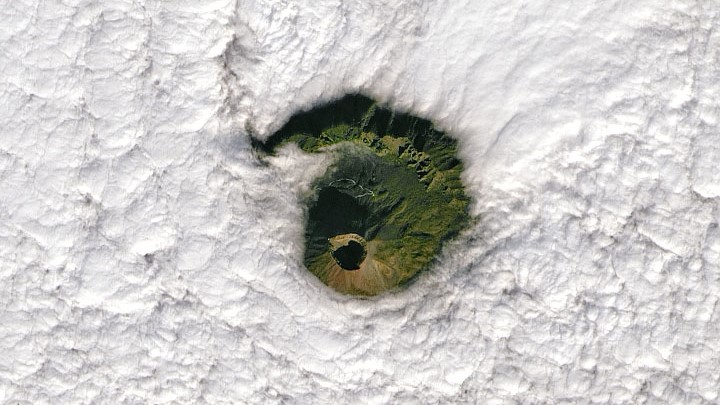
Landsat 8 caught a glimpse of one of the world's most dangerous volcanoes, Mount Vesuvius, as it "peered up" into the sky through an eerie, circular hole in the clouds.
The volcano's summit caldera — a large, bowl-like depression that forms when a volcano erupts and collapses — is clearly visible in the image, as well as part of a large, mountainous ridge to the north, which is a remnant of Mount Somma — an ancient volcano that once stood in the same spot as Mount Vesuvius, before the newer volcano's cone grew from its center.
Vesuvius' most famous eruption simultaneously destroyed and preserved the Roman city of Pompeii, as well as the neighboring town Herculaneum, in A.D. 79.
Researchers have described Mount Vesuvius as "Europe's ticking time bomb" because it is due to have another large eruption soon.
Read more: Striking satellite photo captures Mount Vesuvius peering through a hole in the clouds
Want to see even more amazing satellite images? Then check out some more of our favorite shots from the Landsat satellites.

Harry is a U.K.-based senior staff writer at Live Science. He studied marine biology at the University of Exeter before training to become a journalist. He covers a wide range of topics including space exploration, planetary science, space weather, climate change, animal behavior and paleontology. His recent work on the solar maximum won "best space submission" at the 2024 Aerospace Media Awards and was shortlisted in the "top scoop" category at the NCTJ Awards for Excellence in 2023. He also writes Live Science's weekly Earth from space series.


